Space shuttle Columbia disaster: 20 years later, lessons learned still in sharp focus at NASA – CBS News
Twenty years ago this Wednesday — on Feb. 1, 2003, at 8:48:39 a.m. EST — a sensor in the space shuttle Columbia’s left wing first recorded unusual stress as the orbiter and its seven crew members headed back to Earth to close out a successful 16-day science mission.
Over the next 12 minutes, an on-board data recorder would track a cascade of alarming sensor readings and failures on the left side of the spacecraft that indicated a rapidly escalating catastrophe as the blazing heat of re-entry engulfed the ship.
But it initially played out behind the scenes in the ship’s flight computers, which waged an increasingly desperate struggle to keep Columbia on track for a planned landing at the Kennedy Space Center in Florida where friends and family were waiting.
And so, at 8:53:26 a.m., Columbia crossed the coast of California, right on schedule, at an altitude of 44 miles while traveling 23 times the speed of sound.

Space enthusiasts across the western United States would capture dramatic video of Columbia’s dawn descent, including unusual changes in the shuttle’s white-hot plasma trail along with flare-like points of light separating and falling away. No one knew at the time what, if anything, the light show might mean.
But 16 days earlier, 81.7 seconds after liftoff, a briefcase-size chunk of lightweight foam insulation had broken away from Columbia’s external tank as the spacecraft accelerated through 1,500 mph.
Tracking cameras showed the foam disappearing under the shuttle’s left wing and emerging an instant later as a cloud of fine particles. Later analysis would show the foam impacted the underside of the left wing at a relative velocity of more than 500 mph, instantly disintegrating.

Engineers could not determine exactly where the foam had hit, and Columbia was not equipped with a robot arm to enable an inspection in space.
But an engineering analysis based on software modeling for much smaller impacts indicated the foam strike did not pose a “safety of flight” issue. Senior managers ruled out asking for spy satellite imagery that might, or might not, have allowed a more thorough analysis.
In any case, commander Rick Husband, pilot Willie McCool, mission specialists Kalpana Chawla, Laurel Clark, Michael Anderson, David Brown and Israeli guest astronaut Ilan Ramon were unaware of any problems as they returned to Earth, marveling at the pink glow out the cockpit windows as atmospheric friction built up in the moments before that first unusual sensor reading.
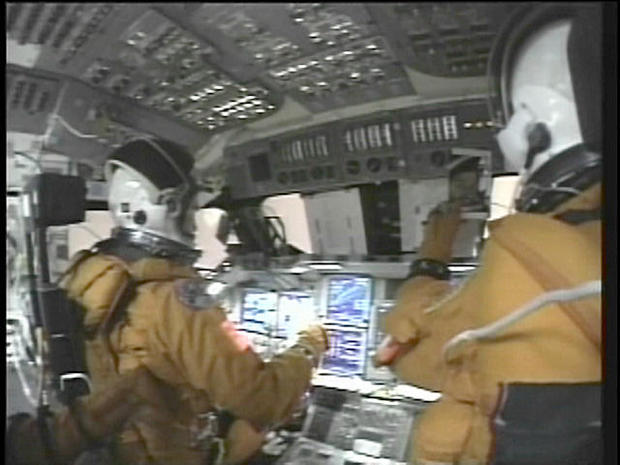
Then, around 8:54:24 a.m. — 5 minutes and 45 seconds after that initial reading was stored in the data recorder — the first indication of trouble showed up in telemetry reaching flight controllers at the Johnson Space Center in Houston: a loss of temperature readings from hydraulic lines in Columbia’s left wing.
Four minutes later, Columbia’s backup flight computer displayed a message in the cockpit indicating a loss of left main landing gear tire pressure readings. Husband called down to mission control, presumably to ask about the tire pressure, but his transmission was cut off.
“And Columbia, Houston, we see your tire pressure messages and we did not copy your last,” astronaut Charles Hobaugh called up from Houston.
“Roger, uh,” Husband began. But again, the transmission was interrupted. It was 8:59:32 a.m.
As engineers would later learn, Columbia veered out of control in the seconds that followed and broke apart 38 miles above central Texas while traveling at 18 times the speed of sound. All seven astronauts, unconscious moments after the crew cabin lost pressure, were killed by blunt force trauma when the cabin came apart in the hypersonic airflow.
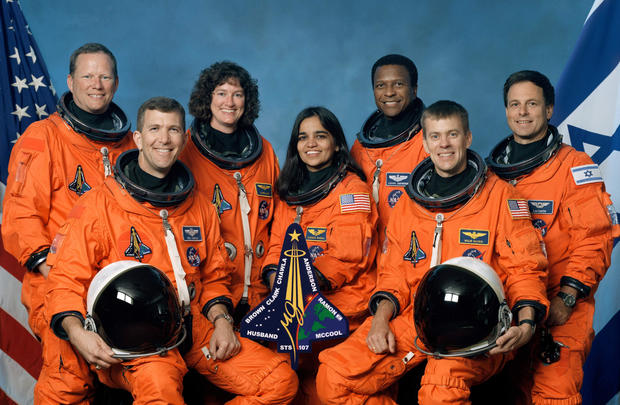
It would take another two-and-a-half minutes or so for the harsh reality of Columbia’s demise to reach the Kennedy Space Center where family members, NASA managers, the ground support team, reporters and photographers were standing by for the shuttle’s homecoming.
Over the days, weeks and months that followed, the Columbia Accident Investigation Board uncovered a now-familiar history of external tank foam insulation problems, management miscues and poor internal communications that contributed to the mishap.
In a dramatic test, engineers used an air cannon to fire a piece of external tank foam at a wing leading edge mockup at the same angle and velocity as the one that damaged Columbia. The impact blasted a hole in the mockup’s leading edge, conclusively proving the lightweight insulation could cause catastrophic damage in a worst-case scenario.
And that’s exactly what happened to Columbia.
During re-entry, super-heated air rushed through a breach in the left wing leading edge, cutting through sensor wiring, melting internal spars and burning into the left landing gear wheel well. The wing eventually either folded over or broke away from the fuselage, throwing the ship out of control.
The Columbia disaster, like Challenger before it, triggered agency-wide soul-searching as the accident investigation proceeded.
- CBS News looked back on the Columbia disaster in 2016. Watch that video in the player below:
NASA’s mission management team was criticized for dismissing the foam strike based on what turned out to be a flawed engineering analysis. The shuttle was not equipped with a robot arm, tools or materials to repair major heat shield damage, and the MMT never considered a high-risk emergency spacewalk to inspect the damage site.
While a NASA study later showed a shuttle rescue mission was possible in theory, no one believed the agency would have launched another crew without first knowing what had happened to Columbia.
In short, Columbia’s fate was sealed 81.7 seconds after liftoff. The real problem, the accident board concluded, was NASA’s earlier failure to properly deal with an ongoing problem: heat shield debris hits from foam insulation coming off the external tank during ascent.
As was well known, every shuttle flight included foam hits to the orbiter’s heat shield even though the agency had a clear-cut rule in place forbidding debris strikes. The rule was never strictly enforced and NASA eventually came to look at foam shedding as an “acceptable risk.”
But concern about the foam ramped up in October 2002, just two flights before Columbia’s, when a piece of insulation the size of a mailbox broke away from the shuttle Atlantis’ external tank seconds after liftoff. The debris slammed into insulation covering an attachment ring at the base of a solid-fuel booster leaving a crater 4 inches wide and 3 inches deep.
It was a close call. The foam struck just six inches away from a critical electronics box used to relay commands to the booster from the shuttle’s flight computers.
Engineers quickly traced the missing foam to one of two bi-pod ramps where insulation was built up around the bases of two struts used to hold the nose of the orbiter to the tank.
On October 31, 2002, NASA managers met at the Kennedy Space Center for a flight readiness review to discuss the shuttle Endeavour’s planned launch on the next space station assembly mission.
The foam loss during Atlantis’ launch earlier that October was just one of several technical issues on the table and the chairman of the meeting, Bill Readdy, a former shuttle commander serving as NASA’s associate administrator for space flight, cautioned everyone to be vigilant.
But during the subsequent discussion, tank managers and engineers argued that problems with Endeavour’s tank were no more or less probable than with earlier tanks built the same way. There was no clear evidence anything was wrong with the next tank in the sequence and while foam shedding was common, the loss of large pieces was rare.
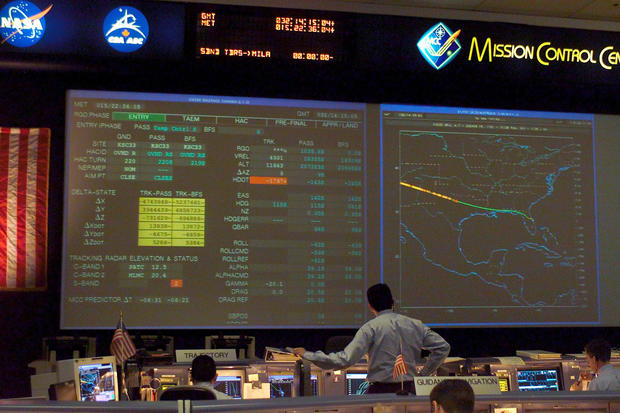
They couldn’t guarantee the upcoming flight would be free of significant foam debris, but the external tank team concluded Endeavour’s was “safe to fly with no new concerns (and no added risk).”
Despite what some viewed as a somewhat suspect “flight rationale,” the flight readiness review ended with formal clearance to launch. Endeavour’s flight did not suffer any significant foam damage and when NASA managers met on January 9, 2003, for Columbia’s readiness review, foam shedding was not on the agenda.
Reviewing the Challenger disaster, sociologist Diane Vaughan called this sort of acceptance of a clearly known problem the “normalization of deviance.”
In that context, then, the beginning of the end came on Halloween 2002 when participants in Endeavour’s flight readiness review agreed to keep flying shuttles before gaining a thorough understanding of the bi-pod foam issue.
The impact of that decision still reverberates across the space program.
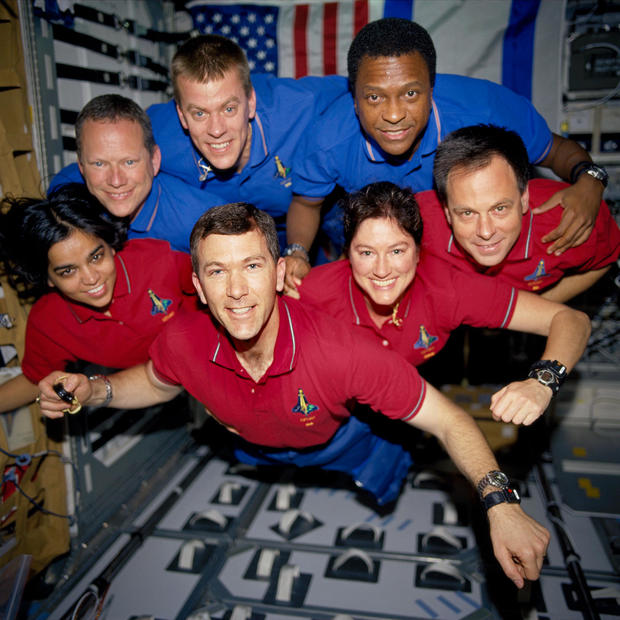
Along with recommended technical and management changes, the Columbia Accident Investigation Board told NASA it must “conduct a vehicle recertification at the material, component, subsystem, and system levels” if the agency wanted to fly the shuttle past 2010, an undertaking that would have been enormously expensive.
Instead, in January 2004 President George W. Bush told NASA to retire the shuttle fleet after completing the International Space Station. The idea was to free up money for new rockets and spacecraft needed to build Antarctica-style moon bases in the early 2020s.
Needing to keep space station crew and cargo flights on track after the shuttle’s retirement, NASA turned to private industry to develop for-profit freighters and space taxis to deliver supplies and to ferry astronauts to and from the lab complex.
SpaceX and Orbital Sciences (now Northrop Grumman) launched the first commercial cargo ships in 2012 and 2013 respectively. SpaceX launched the first astronauts on a Crew Dragon capsule in 2020, ending NASA’s post-shuttle reliance on Russia for basic crew transportation. Boeing is expected to follow suit later this year with its Starliner capsule.
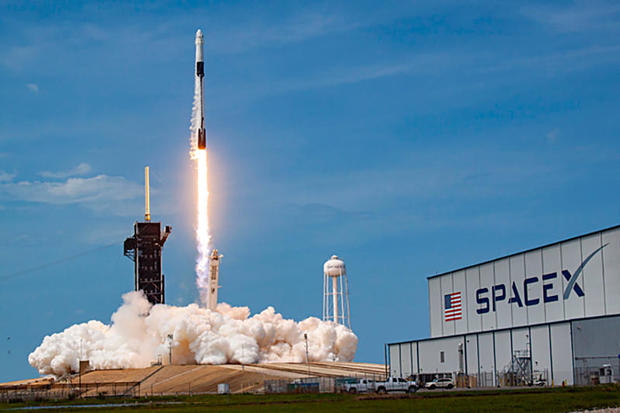
But President Bush’s moon program — Constellation — was never adequately funded and the Obama administration decided it was not sustainable. NASA was told to continue development of the Constellation program’s Orion crew capsule and to build a new rocket, which became the Space Launch System, for deep space exploration.
Then, in 2017, President Trump ordered NASA to accelerate the stalled moon program. The resulting Artemis program launched an unpiloted maiden flight late last year using an SLS rocket and Orion capsule. The agency plans to send four astronauts on an around-the-moon flight — Artemis 2 — in 2024, followed by a moon landing in the 2025-26 timeframe.
But in the immediate aftermath of the Columbia disaster, NASA’s path to the present was not even remotely imaginable. All that was known was that seven more men and women would have their names carved in a Kennedy Space Center memorial.
And there were more hard lessons to re-learn.
“Every day at NASA, we have an opportunity, we have a duty, to carry the memories of those that we lost and carry their dreams onward and upward,” NASA Administrator Bill Nelson told agency employees last week.
“And the bottom line is this: speak up. A question, even a simple question, is more forgivable than a mistake that can result in a tragedy. And each of us has a responsibility to cultivate a work environment where every member of the NASA family feels empowered to voice doubt. Make your concerns heard.”
Thanks for reading CBS NEWS.
Create your free account or log in
for more features.






